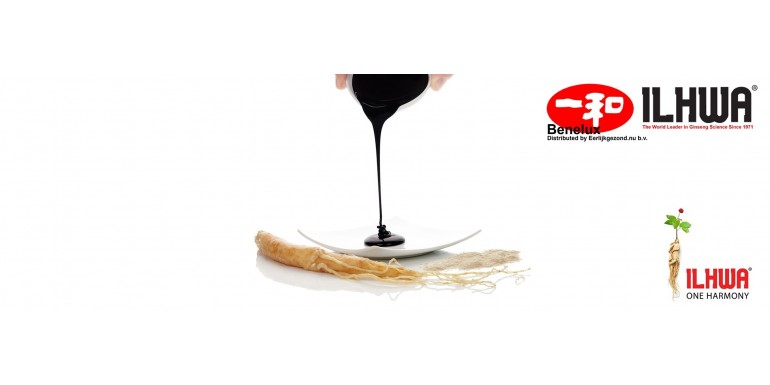
Ginsenosides are steroid-like substances; triterpene saponins. Ginseng contains more than 40 different ginsenosides. The main ginsenosides are Rg1, Rg2 and Rg3. It takes a lot of time and money to have ginsenosides analyzed. Most other ginsenosides in ginseng (in all types) are so minimal that it is difficult to identify them in an analysis.
Now the Korean government (KFDA) has determined that only the Rg1, Rg2 and Rg3 are standardized, these are therefore only analyzed. ILHWA actually always has a percentage of total ginsenosides above 70 mg/g and usually mid 80 mg/g. The Korean government standard for Rg1 and Rg2 is 12 mg/g, but ILHWA is usually around 15 mg/g.
Red and White ginseng
White ginseng means that the root has just been washed, peeled and dried before extraction. Red ginseng, on the other hand, is steamed before drying. The roots turn light brown/red during steaming, which is why they are called red ginseng.
Contrary to what some companies claim, steaming ginseng does not increase the amount of ginsenosides. It does change certain ginsenosides from one type to another so they can claim that more xxx ginsenoside has been made. However, the total ginsenosides is the same and when it is claimed that xxx ginsenoside is increased, it means that other yyy ginsenside is decreased. This process is called deglycosylation of the ginsenosides. As a result, the red ginseng has an increased concentration of Ra1, Ra2, Ra3, Rf2, Tg4, Rg5, Rg6, Rk1, Rs1 and Rs2 ginsenosides. But this means that there is a reduced concentration of the other ginsenosides.
Why is red ginseng popular in Korea?
Ginseng roots are delicate and do not keep for a long time. So they are dried to make them last longer. They can also be kept even longer by steaming. In ancient times this was beneficial because it could be kept longer. Steaming is still done this way and is still the most popular method in Korea. Until the 1980s, red ginseng was monopolized by the Korean Ginseng and Tobacco company owned by the Korean government. They had their own brand, Cheongwan Jung, which, with government funding, was able to produce and sell red ginseng products well. And so, this is another reason why Korean people are still in favor of red ginseng and most of the products are red ginseng.
Why does ILHWA use white ginseng?
The main ILHWA ginseng products are made from white ginseng for a variety of reasons.
- Steaming can create more of certain types of ginsenosides, but in general many ginsenosides as well as minerals and other nutrients will be destroyed as a result of high heat. If you look at other companies, the red ginseng extract usually contains at 40-60 mg/g while white ginseng contains 70-80 mg/g.
- Most red ginseng is extracted with water only, but water is not enough for proper extraction. Alcohol is needed to really get a good extraction. ILHWA uses an ethanol / water solution to extract the roots allowing more ginsenosides and nutrients to be extracted from the roots. Also because of the lower boiling temperature of alcohol, ILHWA can boil down all alcohol and bring the moisture content below 40% without using very high temperatures. (Incidentally, if you want high-quality ginseng extract, you should also pay attention to the percentage of moisture, less than 40%. The ILHWA extract contains less than 40% moisture. Some companies may add water or other ingredients to the ginseng ILHWA does not add water after extraction and evaporates the extracted liquid until there is less than 40% moisture in the extract so that the extract becomes more concentrated). Due to the lower temperature, far fewer nutrients and ginsenosides are lost to heat.The combination of better extraction with alcohol and lower temperature means that the ILHWA white ginseng has a much higher ginsenosides content and is better in quality.
- ILHWA's purpose for ginseng can be explained as 'balanced'. Red ginseng can contain more of one type of ginsenoside, but that means others have been lost. The 40+ ginsenosides are roughly divided into 2 types (there is a third but only a few). Red ginseng only brings out one type where the ILHWA white ginseng brings out both types and the result is a totally balanced ginsenoside content.
What is better?
Despite some claims by companies or traditional practitioners of Eastern medicine, there is no concrete evidence that red ginseng is better for some individuals and white ginseng is better for others. Although there are more than 40 types of ginsenosides, once in the body, they are metabolized in the gut. Because they are broken down by the intestinal bacteria into one of the 2 metabolites, which depends on the ginsenoside type. But what is much more important than whether red or white ginseng is better for a person is whether this person has the right gut bacteria (a good microbiome) to efficiently break down ginsenoside. If the intestine does not have the right bacteria, the ginsenosides will not be metabolized properly and the effectiveness decreases. This is why probiotics are so important and popular today. Without a healthy microbiome, taking many supplements will not help the body.
ILHWA knew this and discovered the pharmacokinetics (how the ginseng is broken down in the body) of ginseng in the 1990s. ILHWA took it a step further and took the ginseng extract and applied the enzyme hydrolysis process to make metabolized ginseng in the lab. This process is patented and forms the basis for GINST15 products. Because the ginsenosides have already been metabolized, GINST15 is absorbed much faster and easier in the body and above all more consistently because no work has to be done by the body. On our site you can find more detailed information about GINST15 and the ILHWA GINST15 products.
